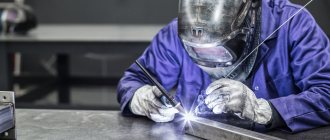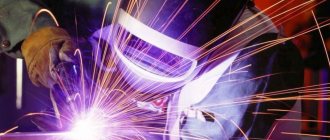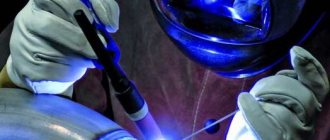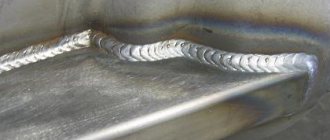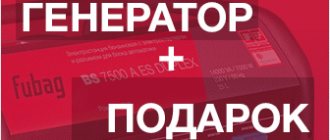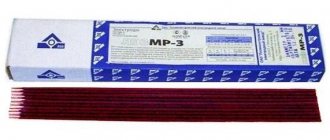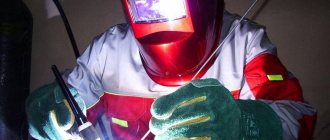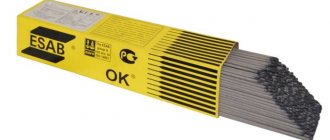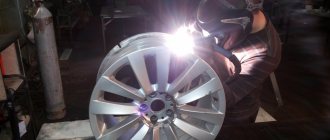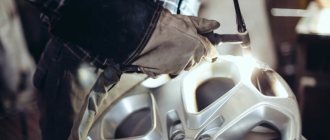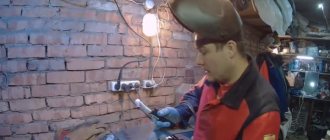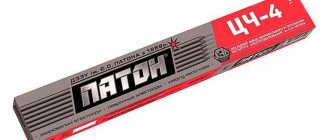11.22.2019 Author: VT-METALL
Issues discussed in the material:
- What are the features and advantages of argon welding of stainless steel?
- How to prepare materials for argon welding
- How is argon welding carried out using a non-consumable tungsten electrode?
- What is argon welding of stainless steel semi-automatically?
- What is important to consider when argon welding stainless steel
Stainless steel is a rather difficult material for welding. However, the use of welding with argon cooling allows you to obtain an even and high-quality seam connecting stainless steel parts. It is necessary to begin learning this process by becoming familiar with the various characteristics of this difficult alloy to join. Our article will introduce you not only to what argon welding of stainless steel is, but also to the features and technology of the work.
Basics of argon welding of stainless steel
Stainless steels differ from ordinary steels in their anti-corrosion properties, which they obtained by adding chromium (up to 20%), nickel, manganese, molybdenum and other components. These impurities give the metal different properties and performance qualities. As a result, this leads to difficulties in argon welding of stainless steel.
The main properties of stainless steels are:
- Thermal conductivity is two times less than that of low-carbon steels. The outflow of heat from the argon welding site occurs very slowly, as a result of which the working area can overheat and burnout is possible. Therefore, the welding current should be 20% less than when working with other steels.
- The coefficient of linear expansion of stainless steel is high.
Accordingly, the change in the length of the product during heating will be significant, which can lead to its deformation or the appearance of cracks. To prevent this, it is necessary to make sufficiently large gaps between the parts being connected, especially large ones. - High specific electrical resistance - as a result of which the electrode rod heats up. To obtain a high-quality connection, you must follow the rule - to create short seams, use long electrodes with a higher resistance. When argon welding large areas, it is necessary to take electrodes measuring 35 cm.
An important feature of stainless steel is the loss of anti-corrosion properties at the joint when heated to temperatures above +500 °C. The reason is the formation of carbides at the grain boundaries, which take on the role of anodes. They lead to an increase in the rate of intergranular corrosion of alloys.
We recommend articles on metalworking
- Steel grades: classification and interpretation
- Aluminum grades and areas of their application
- Defects in metal products: causes and search methods
To protect stainless steel from overheating during welding, the argon cooling method is used. And for chromium-nickel alloys - technology for rapid cooling of the weld.
The process of welding aluminum with argon: step-by-step instructions
The main thing for beginners mastering this technology is strict adherence to simple rules:
- To create an even seam, the workpieces are pre-grabbed on both sides.
- The filler wire is fed after the weld pool appears. It is important not to hesitate so as not to burn a hole in the metal.
- When welding aluminum with argon, the arc length is maintained at 3 mm.
- The electrode is placed at an angle of 80⁰, and the wire is perpendicular to it. To prevent aluminum from splashing, it is fed smoothly, without jerking.
- If thin aluminum is being welded, the electrode is guided along the joint without lateral movements. When working with workpieces thicker than 3 mm, zigzag vibrations are allowed.
- Argon welding technology involves the movement of the wire in front of the electrode.
- The seam is completed by pressing a button on the machine, which turns on the arc decay timer.
- The burner position is not changed until the end of argon purging.
- A properly made seam has a ribbed surface without pores or cracks.
Having mastered the technology of argon arc welding of aluminum, you can make good money. For 1 cm of such a connection they pay 45 or more rubles. But to become a sought-after specialist, you will first have to train to learn how to create reliable seams.
Advantages of argon welding of stainless steel
When choosing an option for welding work on stainless steel, argon welding has a number of advantages that are determined by the technology, namely:
- To obtain an even weld with uniform penetration to the entire depth, it is necessary to protect the metal from exposure to air during operation. Argon helps to do this, creating a special atmosphere around the work site, displacing N2 and O2.
- This method helps to connect parts of complex shapes without changing their configuration due to the low thermal conductivity of stainless steel. Only a small area near the seam is heated. On the one hand, this is good, but on the other, you need to act very carefully so that burnout does not occur.
- The connection occurs quite quickly because the arc temperature is high.
In addition to its advantages, argon welding also has disadvantages. To carry it out, you need complex and expensive equipment, as well as certain work experience, knowledge of the material and the process.
Advantages and disadvantages
Argon-arc welding has both features and disadvantages. Of course, there are more positive aspects to it, and they are as follows:
- You can weld not only copper and aluminum, but also steel.
- The seam is neat from an aesthetic point of view, subject to the technique of feeding the rod and applying the arc.
- Argon-arc welding of non-ferrous and ferrous metals can be done at home with your own hands if you have the necessary equipment and consumables.
- The connection is strong throughout the entire depth of the joint if the parts have been well prepared in advance. The chamfer was removed at an angle of 45 degrees, a gap was provided and the oxide film was removed from the surface.
- In this way, you can weld thin parts without penetration and other undesirable defects.
- When automating the welding process, it is performed not only efficiently, but also quickly.
The disadvantages include:
Complexity of the process. Without the right equipment, you will not be able to perform high-quality welding. In addition, it is necessary to have some experience in order to correctly feed the bar and control the arc. Therefore, a beginner in this matter will have to learn a lot.
Also, the price of professional equipment will be quite high, but you can assemble the components separately, which will be somewhat cheaper.
How to set up argon welding on stainless steel: preparation nuances
An important stage that influences the final result is the process of preparing stainless steel for subsequent argon welding:
- Carefully process the edges of the parts with a wire brush, sandpaper, or perform automatic grinding.
- Degrease with acetone, alcohol or gasoline.
- Position the parts to be welded with clearance for expansion.
- Heat the edges of the parts to +200…+300 °C when working on thin stainless steel. This will help reduce the tension in the metal and avoid cracks.
The next stage is the selection of filler material or wire. There should be more alloying additives in it than in stainless steel intended for welding. The cross-section of the wire is selected based on the thickness of the parts being connected.
Argon welding technology with a non-consumable tungsten electrode
Using a tungsten electrode, argon welding is used to connect parts with thin walls (thin-walled). This method is called TIG welding.
Two types of devices are used for work: direct or alternating current. Argon is supplied through a torch with an inserted tungsten electrode. The seam is formed by melting the filler wire, which is fed manually. The burner is also moved manually, holding it strictly at an angle of 70–80° to the seam.
VT-metall offers services:
The burner moves along the connection line, without transverse movements. In this way, a stable weld pool is formed, excluding the ingress of atmospheric oxygen and its interaction with the metal. It is recommended to simultaneously supply argon from both the front and back sides of the seam. Despite the higher gas consumption, the quality of the connection will be higher.
The electrode should not come into contact with the surface of the stainless steel. To ignite the arc, carbon or graphite plates are used, and then it is transferred to metal. This is done to prevent melting of the electrode and the absence of marks on the welding seam.
Operating principle of welding equipment
The welding equipment includes:
- A welding machine of any type for arc welding with an open circuit voltage of 60-70 volts.
- Power contactor, with the help of which voltage will be supplied from the welding machine to the torch.
- Oscillator. This device converts a mains voltage of 220 volts and an oscillation frequency of 50 Hz into a voltage of 2000-6000 volts with a frequency of 150-500 kHz. These electric current parameters make it easy to ignite the arc.
- A device for blowing the welding zone with argon.
- Ceramic burner.
- An argon cylinder is connected to the burner through a reducer and a hose.
- Non-consumable electrode and filler wire.
You can watch a video on how argon welding works, but this is the principle. First, the welding mode is adjusted and the metals being joined are cleaned. The torch is taken in the right hand, the filler wire in the left, it is not connected to electricity. There is a special button on the torch handle with which you can supply protective gas to the welding zone. The gas supply is turned on 20 seconds before the start of welding work.
https://www.youtube.com/watch?v=TlFlVegc40U
The burner must be lowered so that there is a small distance between the non-consumable electrode and the surfaces to be welded - within 2 mm. By the way, the electrode is inserted into the burner in such a way that an end no longer than 5 mm protrudes from it. There is a latch inside the burner into which an electrode of any diameter can be inserted.
The welding machine is turned on and voltage is supplied to the electrode. An arc appears between it and the metals being joined. At this time, argon is supplied from the burner nozzle, which covers the welding zone. The welder feeds filler wire into the welding joint, which melts under the action of an electric arc and covers the gap between the parts. In this case, a slow movement is made along the seam.
Do not ignite the electrode by contacting it with the metals being welded. An oscillator is specially used for ignition, as shown in the video.
Semi-automatic argon welding of stainless steel
Semi-automatic argon welding greatly simplifies the process, increases its speed, and also improves the quality of the weld. Most often, semi-automatic machines are used to connect parts of large thickness.
There are several features of argon welding of stainless steel using a semi-automatic machine:
- use of nickel-containing wire;
- consumption of carbon dioxide together with argon when joining thick parts - the edges of the seam are wetted with gas, reducing heating, which leads to a softening of the entire process;
- the use of three connection methods: with a short arc, with jet transfer technology or a pulse method.
It is believed that the greatest control of the process occurs during pulse welding, when the wire is fed into the work area in jerks. At the same time, its consumption is reduced, which is important due to its high cost. The heating area of the metal is reduced. Spattering is reduced.
This results in reduced post-finishing time for surfaces close to the weld because there is no molten metal splash.
Features of argon arc technology
Like arc welding, argon welding technology is based on melting the area where metals are joined using an electric arc. It can be carried out using melting and non-melting electrodes.
Non-consumable electrodes are usually products made from tungsten, since it is distinguished by its refractoriness and can withstand the temperature of the metal melt. The official designation for welding with non-consumable tungsten electrodes in a neutral gas environment is TIG.
In this case, the metal joining zone is filled with filler material. To do this, use metal wire made of an alloy alloyed with the same elements as the metal being welded. The main rule when choosing it is not to deteriorate the properties of the base metal of the weld. Therefore it is important:
The percentage of alloying elements in the filler wire should not be less than in the metal parts being joined.
The diameter of the wire is selected in accordance with the parameters of the weld and the thickness of the product.
When using consumable electrodes, wire or rod is used as their material, which also, according to the requirements for the chemical composition, must correspond to the base metal of the product and, when melted, must not deteriorate its properties.
Argon arc welding with blowing can be carried out in three ways:
- in full automatic mode;
- in automatic wire feed mode;
- in manual mode of the process.
In automatic mode, the entire welding process is fully automated: both the movement of the electrode and the supply of filler wire are controlled by an automatic machine.
In semi-automatic mode, the welding machine is controlled by a person, and the feed of filler wire is adjusted automatically.
In manual mode, the entire welding process is carried out by a welder.
Neutral gas in the welding zone has two functions. It serves as a protective medium against the aggressive action of air components and regulates the passage of a current pulse through ionization by the arc.
In argon arc welding, these functions are provided by argon gas. It prevents the molten weld metal from interacting with air components, since it is significantly heavier than air (38%) and therefore squeezes it out of the weld zone, filling the working space and reliably isolating the melt from contact with the atmospheric environment.
For what purposes is the protective environment used? The fact is that when high temperatures are reached, many high-alloy steels and alloys of non-ferrous metals easily react with oxygen and nitrogen present in the air, forming compounds that harm their strength and deprive them of resistance to corrosion. Argon is a neutral gas; it does not react to the components of heated metal alloys, therefore it serves as a kind of curtain that prevents contact of the heated metal with air, preventing it from interacting with aggressive air gases.
Sometimes, especially during bath welding, a small volume of oxygen (3-5%) is added to argon to eliminate the formation of porosity in the welded metal. It takes on the role of a liquid melt cleaner, interacting with its surface harmful inclusions, which subsequently burn out or float to the surface of the melt in the form of slag.
In addition, inert gas has an increased tendency to ionize, and this affects the nature of the passage of directed electrons of the welding arc to the surface of the metal, and, consequently, the parameters of the welding current.
What equipment is used for argon welding of stainless steel
For argon welding of stainless steel you need:
- Inverter welding current source (welding inverter) is a power source for the welding arc, ensuring its stable combustion. Its choice depends on the scope of work and the properties of the metal. Experts advise using a source operating on rectified current for stainless steel.
- An oscillator is an electronic device that maintains and stabilizes the welding arc when using a non-consumable tungsten electrode.
- Burner and conductive assembly - includes a gas nozzle and a non-consumable electrode.
- Argon or its mixtures with other gases is supplied from cylinders where it is under pressure.
- Non-consumable electrodes - currently, electrodes for argon welding of corrosion-resistant stainless steel are widely available on the market. The choice depends on the seam and the properties of the material.
- Filler wire – selected depending on the grade of stainless steel.
- Overalls - overalls, gloves and mask. As well as products for treating stainless steel - degreaser and wire brush.
Types of welding equipment
Four types of equipment are used for argon welding.
- Manual (shown in the video) is when the welder holds both the torch and the filler wire with his own hands.
- Mechanized version - the welder holds the torch, and the wire is fed mechanically.
- Automatic argon arc welding - the welder is absent, he is replaced by an operator who monitors the process, because both the torch feed and the filler wire feed occur automatically.
- Robotic welding process. A program is set that is fully responsible for the process being carried out.
The most important advantage of argon arc welding is the ability to weld parts of those metals that cannot be joined in other ways. And in everyday life such situations often occur, for example, joining stainless steel pipes. Be sure to watch the video on this page of the site.
Setting up the machine and the details of argon welding of stainless steel pipes
Creating stainless steel pipelines requires connecting its parts. A feature of such welding work is the need to protect the seam with gas inside the pipe.
For this purpose, use the method of plugging one end of the connected pipe with improvised materials:
- paper;
- foam;
- rubber;
- cloth or etc.
The tube required to supply argon is inserted into the plug. After which the structure is secured with tape. Argon is supplied under low pressure, which is determined by visual inspection. The main criterion is the absence of molten metal in the air blown from the pipe.
A homemade but convenient design will help make the welding seam smooth and of high quality.
To connect stainless steel 3 mm thick, the device is set to a current of 65 A. Welding the weld crater should last 3 seconds. And the supply of argon after completion of work is 4 seconds.
Final recommendations from specialists in argon welding of stainless steel
Using argon welding for stainless steel requires experience and knowledge, which can be obtained from specialists in this field - professional welders.
Here are some of their recommendations:
- You need to work by holding the electrode at the shortest distance from the metal, but without touching it. This creates the smallest possible arc. This is done to improve the quality of the seam. Since a long arc will not heat the seam in depth, as a result of which it will expand.
- It is necessary to feed the wire evenly, trying to keep it in the zone of action of argon. This will help avoid oxidation during manual argon welding.
- The quality of the melt can be assessed by the shape of the beads that appear as a result of melting the filler wire. The shape stretched along the seam indicates good quality. A circular or oval flow will indicate insufficient or incomplete penetration.
- Gradually reduce the current value, approaching the end of the seam. It is necessary to avoid sudden separation of the arc to increase the level of protection of the hot weld and, accordingly, its quality.
The argon welding method, although considered complex, is not so. It's not much harder than usual. It can be mastered in a fairly short time, and professionalism will come with experience. The cost of additional equipment will be more than paid for by the ability, in addition to stainless steel, to weld copper, aluminum or bronze parts, as well as their alloys.
Required equipment, supplies and protection
When planning to do argon manual welding at home (automatic machines are usually not used at home), you should stock up on everything you need in advance:
- gas cylinder. For argon, specialized cylinders are used, the difference from oxygen and propane cylinders is in the colors. They have a characteristic silver-gray color;
- reducer to reduce the pressure of liquefied gas. Can be specialized or general purpose;
- a high-pressure hose (from the cylinder to the reducer) and a similar or less durable one - from the reducer to the welding torch;
- a welding machine designed to work with non-consumable electrodes;
- electrodes of a suitable brand in the required quantity;
- tools and devices for preparing metal for welding;
- protective clothing and equipment.
It is important to understand that the compatibility of the cylinder, hose and reducer is very important. To avoid confusion, manufacturers try to produce reducers and cylinders in the same color and with similar markings.
More about the equipment
Please note that the previously provided information about the color of the argon cylinder (silver-gray) refers to PURE (specially prepared) gas.
It is also necessary to pay attention to the marking of the cylinder itself and its condition.
The condition of the threads and seals should be examined especially carefully, since the performance of the cylinder as a whole and the safety of its use depend on this.
It is advisable to use the reducer with a rotameter (one or two), that is, a gas flow sensor and regulator. Two rotameters are necessary if two welders will use the gas cylinder at the same time. The presence of a rotameter allows you to rationally use both the gas itself and tungsten electrodes - after all, with excessive gas pressure, they burn out much faster.
With regard to electrodes, it is necessary to adhere to the general rule regarding the type of welding (AC or DC).
The diameter of the product is selected depending on the thickness of the metal to be welded.
The same goes for the required welding amperage.
The last parameter, as well as the ability to use different electrode diameters, greatly influences the choice of welding machine.
We will not consider the nuances of choosing a specific device model within the framework of this article, since the topic is too broad.
Preparing parts
To weld any metal, it must first be prepared for work. This procedure includes several steps:
- editing details. Often the parts that need to be welded are deformed. The basic shape must be restored, otherwise joining for welding may be impossible or very difficult. Straightening is performed manually or using automatic equipment, “cold” or in a heated state (using a gas burner). The choice of a specific method depends on the characteristics of the part, its condition and the capabilities of the craftsman;
- cleaning surfaces. It is necessary to remove the corroded layer and any paint and varnish coatings from the part. This is usually done by hand sanding or wire sanding with a drill/grinder;
- marking and cutting. Marking at home is done only by hand; cutting is carried out with a grinder or a special metal saw (including using a jigsaw). For thin sheet metal, you can use scissors. Thermal cutting is also possible - using a gas cutter, electric arc, and so on;
- preparing edges for work. Depending on the thickness of the metal you plan to weld, straight, V-shaped and X-shaped edges are used. The mechanically or thermally cut edge of a part must be brought to any condition using a suitable hand tool. In this case, it is better to use “cold” cutting methods, since after thermal cutting, the cleanliness of the cut to form a chamfer or a flat surface may not be sufficient. Additionally, the edges can be cleaned from the oxide film using a wire brush or a grinding attachment.
Another important point is the removal of stains of oils, fats and other organic and inorganic contaminants. They are removed with appropriate solvents.
The last stage of preparation is assembling the parts in the required position. For this purpose, various stands, conductors, etc. are often used. Particular care should be taken when welding pipes and other hollow parts joined at the edges.
Types of edges for welding: 1 – straight edges, 2 – simple V-shaped, 3 – complex V-shaped, 4 – X-shaped
The assembly of parts must be carried out taking into account a significant increase in temperature in the welding zone - wood and other flammable materials cannot be used for the welding stand.
